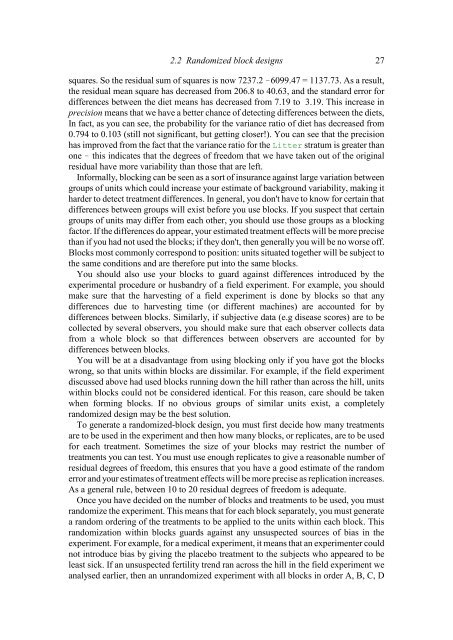Download pdf guide - VSN International
Download pdf guide - VSN International
Download pdf guide - VSN International
You also want an ePaper? Increase the reach of your titles
YUMPU automatically turns print PDFs into web optimized ePapers that Google loves.
2.2 Randomized block designs 27squares. So the residual sum of squares is now 7237.2 6099.47 = 1137.73. As a result,the residual mean square has decreased from 206.8 to 40.63, and the standard error fordifferences between the diet means has decreased from 7.19 to 3.19. This increase inprecision means that we have a better chance of detecting differences between the diets,In fact, as you can see, the probability for the variance ratio of diet has decreased from0.794 to 0.103 (still not significant, but getting closer!). You can see that the precisionhas improved from the fact that the variance ratio for the Litter stratum is greater thanone this indicates that the degrees of freedom that we have taken out of the originalresidual have more variability than those that are left.Informally, blocking can be seen as a sort of insurance against large variation betweengroups of units which could increase your estimate of background variability, making itharder to detect treatment differences. In general, you don't have to know for certain thatdifferences between groups will exist before you use blocks. If you suspect that certaingroups of units may differ from each other, you should use those groups as a blockingfactor. If the differences do appear, your estimated treatment effects will be more precisethan if you had not used the blocks; if they don't, then generally you will be no worse off.Blocks most commonly correspond to position: units situated together will be subject tothe same conditions and are therefore put into the same blocks.You should also use your blocks to guard against differences introduced by theexperimental procedure or husbandry of a field experiment. For example, you shouldmake sure that the harvesting of a field experiment is done by blocks so that anydifferences due to harvesting time (or different machines) are accounted for bydifferences between blocks. Similarly, if subjective data (e.g disease scores) are to becollected by several observers, you should make sure that each observer collects datafrom a whole block so that differences between observers are accounted for bydifferences between blocks.You will be at a disadvantage from using blocking only if you have got the blockswrong, so that units within blocks are dissimilar. For example, if the field experimentdiscussed above had used blocks running down the hill rather than across the hill, unitswithin blocks could not be considered identical. For this reason, care should be takenwhen forming blocks. If no obvious groups of similar units exist, a completelyrandomized design may be the best solution.To generate a randomized-block design, you must first decide how many treatmentsare to be used in the experiment and then how many blocks, or replicates, are to be usedfor each treatment. Sometimes the size of your blocks may restrict the number oftreatments you can test. You must use enough replicates to give a reasonable number ofresidual degrees of freedom, this ensures that you have a good estimate of the randomerror and your estimates of treatment effects will be more precise as replication increases.As a general rule, between 10 to 20 residual degrees of freedom is adequate.Once you have decided on the number of blocks and treatments to be used, you mustrandomize the experiment. This means that for each block separately, you must generatea random ordering of the treatments to be applied to the units within each block. Thisrandomization within blocks guards against any unsuspected sources of bias in theexperiment. For example, for a medical experiment, it means that an experimenter couldnot introduce bias by giving the placebo treatment to the subjects who appeared to beleast sick. If an unsuspected fertility trend ran across the hill in the field experiment weanalysed earlier, then an unrandomized experiment with all blocks in order A, B, C, D
















